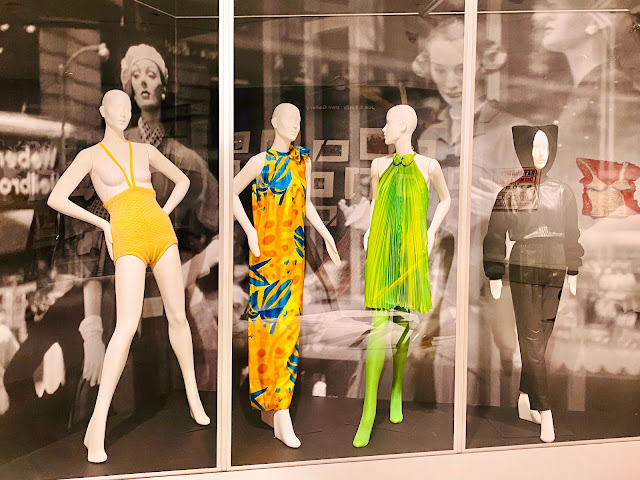An excellent exhibition at the Jewish Museum introduces the art of the Sixties before the decade really took hold in the popular imagination.
 |
| "Spread" by Kenneth Noland (1958) |
 |
| "Braselette" by Claes Oldenburg (1961) |
Female artists were finally beginning to get some traction in the art world.
 |
| "Girl with Radish" by Marjorie Strider (1963) |
 |
| Self Portrait by Marisol (1961-62) |
Queer ones, too. I've read about Jack Smith's Flaming Creatures for years but had absolutely no idea what his experimental film was about. I still don't.
Many well-known artists today were just beginning to show their work.
 |
| "Store Front Project" by Christo (1964) |
 |
| Chair by Yayoi Kusama (1962) & "Thief #1" by Jim Dine (1964) |
 |
| "Woman Brushing Her Hair on Green Chair" by George Segal (1964) |
The exhibit also features rooms decorated in exaggerated period style. Jackie on the end table, Marilyn singing "Happy Birthday" to her husband on the boob tube!
TV also beamed images of the peaceful Black protesters and angry southern bigots into American homes. Many historians credit it with changing minds. I became aware of the Civil Rights movement more through magazine coverage because my father was stationed in France and Germany during the time of this exhibition.
African American artists were producing little-seen work on the same subject.
 |
| "Freedom Now!" by Reginald Gammon (1963) |
 |
| "American People #4, The Civil Rights Triangle" by Faith Ringgold (1963) |
 |
| "Chaino" (partial) by Melvin Edwards (1964) |
A few white artists had something to say, too. This work may allude to Ralph Ellison's novel.
 |
| "Invisible Man" by May Stevens (1963) |
The Museum of Modern Art acquired this painting, inspired by an actual photo in Life magazine, and exhibited it on the 100th anniversary of the Emancipation Proclamation in 1963.
 |
| "The Last Civil War Veteran" by Larry Rivers (1959) |
Everybody my age remembers where they were on November 22, 1963. I was on a field trip in Heidelberg and came home to find my mother--a Nixon voter--in tears. It's impossible to imagine that kind of across-the-aisle grief today.
Andy Warhol was still working in the shadow of the Abstract Expressionists. In March 1963, he and Marisol were photographed in front of "Barge," a 32-foot long canvas by Robert Rauschenberg at the Jewish Museum.
Warhol produced "Jackie Frieze" and Empire, one of his early underground movies, shortly after the assassination. I remember being fascinated by him and the Factory through reports in Time magazine.
I love unsung heroes. Not Robert Rauschenberg (left), of course, but Alan Solomon, an early director of the Jewish Museum and chair of the government committee that selected Robert Rauschenberg and Frank Stella, along with six other artists he had exhibited at the museum, to represent America at the 32nd Venice Biennale.
After Rauschenberg nabbed the Grand Prize, New York became the center of the art world as pop art took off.
 |
| "Third Time Painting" by Robert Rauschenberg (1961) |
 |
| "Marrakech" by Frank Stella (1964) |







No comments:
Post a Comment